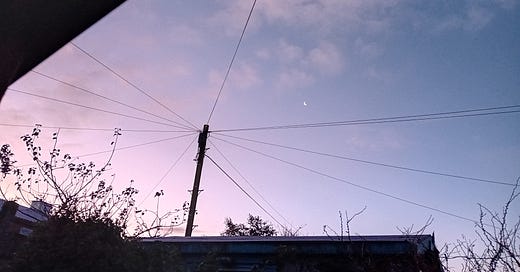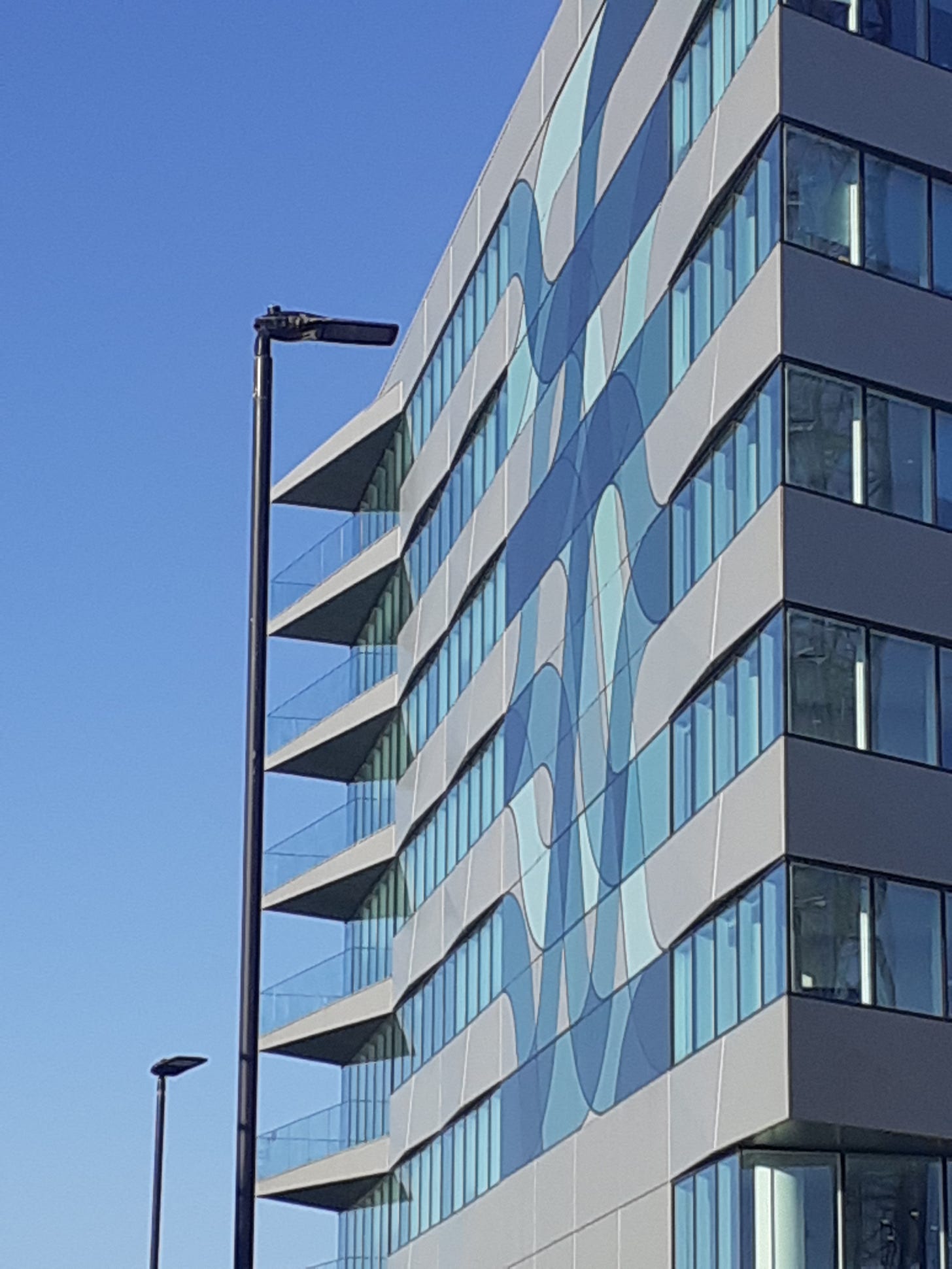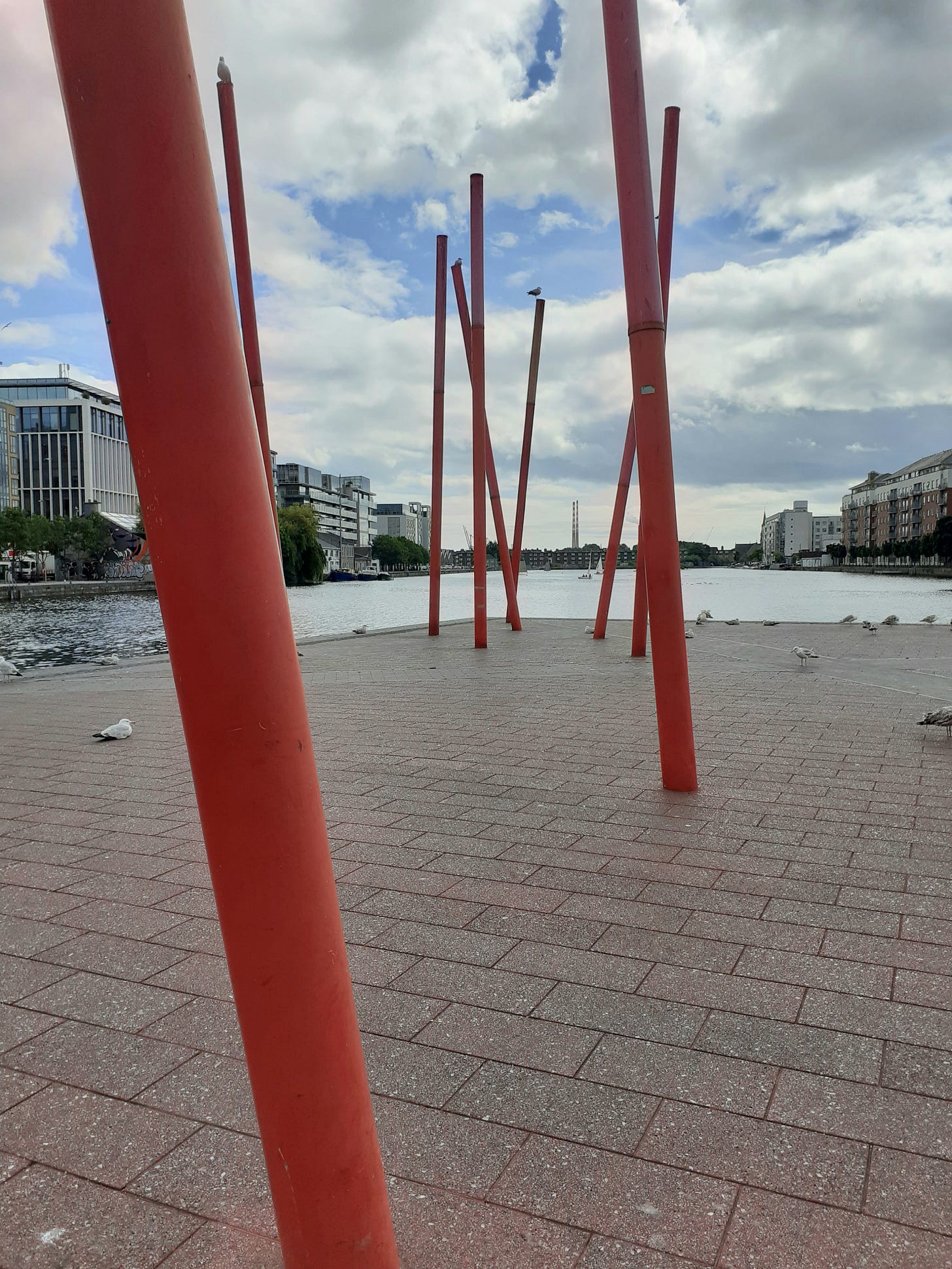Lines and connections
How do we define and shape our place in the physical world? In time? In society?
I’ve come to love dry, chill winter mornings, in the moments just before the sky starts to brighten and there is a supernatural luminosity in the blue…sometimes the odd star faintly winking before it disappears. I throw an anorak over my pyjamas and head out to my garden seat with the steam rising from my coffee. The jackdaws are wheeling and cawing overhead and the neighbours’ black and white cats are on the prowl. I steal a few moments of stillness to sort my head out for the day, finish my coffee and see what’s going on with my plants. These thinking moments are most precious- before the chaos of the school day. Of late I’ve become rather enamoured of the power cables that converge above my shed- not the cables themselves- one could hardly call them beautiful, but the lines they make against that ethereal dawn sky. They fan out like inky bicycle spokes or a starfish if it had been drawn by Tim Burton. These power cables make very beautiful lines.
Now that I’ve noticed them I can’t stop noticing them. These mornings their strands gleaming with morning rain shine like strung pearls, following the line of the River Clyde and the railway all the way back to Glasgow. I do have a soft spot for powerlines that goes a long way back to a day when hopelessly lost in the thick mist of the Wicklow mountains. Having lost all familiar or decipherable landmarks, my friends and I were eventually able to make out the faint traces of powerlines and follow them back to civilisation, but that’s an adventure for another day’s telling.
Today I am writing about lines. Is it a universally human thing to imagine or see the world, to imagine time, in a linear fashion? And if so, have we humans always been doing this? Perhaps we have.
About 2,000 years ago on the far side of the world, the Nazca people of Peru carved a series of extraordinary geoglyphs into the rock of the Pampa Colorada, measuring approximately 50 to 300 metres in length. UNESCO Lines and Geoglyphs of Nasca These extraordinary carvings when seen from the surrounding mountain-tops, or the air form birds, fantastical creatures and plants. How on earth this was achieved remains a mystery; but what a phenomenal act of imagination, the ability to visualise these lines stretching out into the distance beyond sight and then to inscribe them into the earth. As for the why- were they territorial delineations or simply works of art? Do they represent some vision of the future? Whatever their purpose these ancient lines transcend time, space and culture, connecting us to our ancestors and the universally human impulse to make our mark on our physical environment.
Lines in the landscape, either carved into rock or inscribed onto structures have also served as markers of the passage of time. When I was field working in County Sligo in the north-west of Ireland in 2000-2001 I spent a lot of time in the megalithic burial complex at Carrowmore. Like the famous passage tomb at Newgrange, archaeologists have discovered alignments with the rising sun corresponding to seasonal transitions where on certain days the light enters the tombs through a roof-box aperture to illuminate a central chamber or carved megalith. To this day, these monuments reveal the lines of light and shadow to mark transitions in the year. I’ve always found this a little bit magical. A few weeks ago when watching Professor Alice Roberts’ series, Ottoman Empire by Train, I was fascinated by her descriptions of a series of stone carvings at Gobekli Tepe in Turkey. In this 12000 year old site (one of the most ancient man-made monuments yet to be discovered), lines and v-shaped markings have been found to correspond to the movements of the sun- possibly the world’s first solar calendar.
Have humans always perceived the linear, I wonder? Have we always had an impulse to measure and create shape or are we simply mirroring the actions of nature? Consider where humans have formed patterns of settlement- along the pathways of rivers, tree-lines, coastlines. Consider how man-made lines over the centuries have become the directive forces for settlement- railways, bridges, motorways, telecommunication lines, lines on maps. It is both astonishing and ironic that we could now be living in a post-linear society- the globally networked world where the lines of human geography are increasingly being erased though digital communications and AI. And yet…And yet... Are all forms of digital communication and even AI just complex forms of linear projections? The mathematics and technology of these things fry my brain but what if the thinking behind these technologies was as ancient as the line carvings at Gobekli Tepi- the idea that set of lines and symbols read as a code in the same way as an algorithm or a prompt- the idea that a set of lines and symbols could communicate across time and space?
Thinking about that makes me wonder what, in another 12000 years, will survive of today’s linear thinking and inscribing? Will it be the artefacts of our digital innovation, our infrastructure? Our lines of literature and art or the lines we etch into the bones of the earth? What lines will lead the archaeologists and anthropologists of the future back along the contour lines of history to where it all began? Big questions.
I’ll leave off with a few of my ‘line’ photos from various places, human-made and natural. If any of these ideas chime, you can leave me a line 😉
Bristol lines ~ 2022
Dublin lines ~ 2023
Loch Lomond lines ~ 2024








We visited Carrowmore when we were in Ireland in the summer. Amazing place.